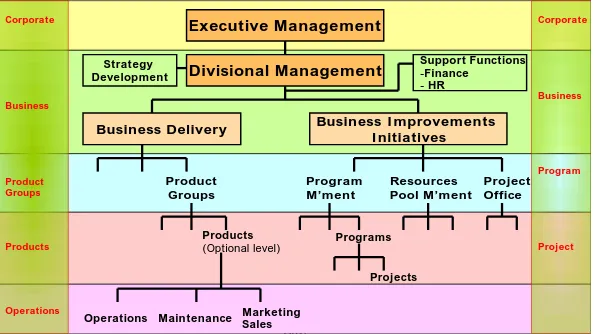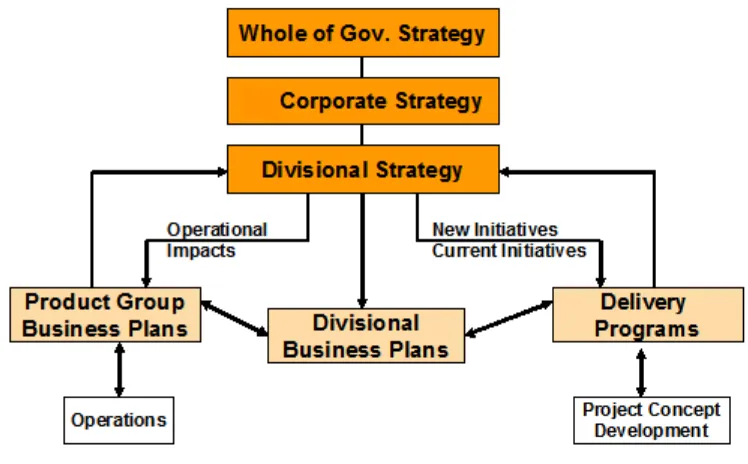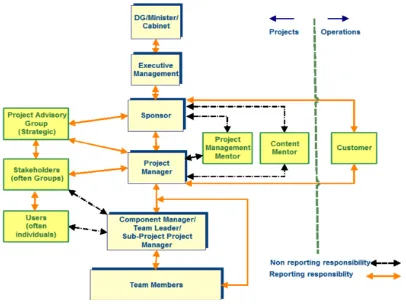*Corresponding Author: Steve McGrath email: kasmac99@yahoo.com.au Page 1 of 11
OnQ - A JOURNEY THROUGH PROJECT, PROGRAM AND
PORTFOLIO METHODOLOGY
S.K.McGrath* B.E., M.Eng.Sc., MIE Aust, CPEng, Dip.PM, RPM Queensland Transport
1. INTRODUCTION
Queensland Transport set out in 2000 to develop a culture that embraced project management as being integral to the delivery of its business outcomes. Five years on, what has been achieved and what has changed?
The paper describes Queensland Transport’s journey through successfully developing a project management improvement project and a methodology for improving its project management within an asset management context, then developing this further into program and portfolio management. It covers the relationship between business management, asset management and project management, and their underlying governance arrangements, as well as the relationship between its OnQ project management framework and program and portfolio management. It describes the approach taken in achieving this, emphasising the culture change aspects. It also gives details of how to access the OnQ internet site.
2. ORGANISATIONAL ENVIRONMENT
The transport portfolio in Queensland comprises Queensland Transport (QT) and the department of Main Roads (MR) along with Government Owned Corporations (GOCs) which include Queensland Rail (QR) and Port Authorities. Queensland Transport responsibility covers both public transport and freight by land, sea and air. It also handles driver licensing and vehicle registrations.
Queensland covers an area of approximately 1,730,000 square km and has a 7,400 km coastline. It is seven times the area of the United Kingdom, is more than twice the size of Texas and five times larger than Japan. Queensland has a population of 3.73 million. Its transport task is carried by 177,000 km of road network, 9,600 km of rail track, 130 airports, including two of Australia's largest international airports, 15 trading sea ports and two community sea ports. Queensland has 2.59 million licensed drivers, 3.35 million registered vehicles, and over 184,000 registered recreational vessels.
Each year in Queensland approximately 315 million tonnes of freight is moved by road, sea, rail and air, and road vehicles travel 38.5 billion kilometres. An estimated 197 million tonnes of goods pass through Queensland ports, 644,000 passengers trips are made on public transport and over 6,300 ships visit Queensland ports. (Queensland Transport 2004)
Queensland Transport's vision is better transport for Queensland – connecting people, goods and services to enhance economic, social and environmental well-being. Its mission is to lead, develop and manage a transport environment which is safe, secure, inclusive, ecologically sustainable and promotes a strong economy.
*Corresponding Author: Steve McGrath email: kasmac99@yahoo.com.au Page 2 of 11 employed 4764 staff, of whom 2597 were in permanent roles, 417 were in temporary roles and 1772 were in casual roles. The budget for 2005-06 is $3 billion.
While QT is still heavily involved in operations and regulation, the proportion of project based work had been steadily increasing, with a multitude of business development projects, as well as planning, design and construction of busway and maritime projects. Project management was therefore becoming an increasing part of QT’s business, with projects frequently transcending internal divisional and sometimes departmental boundaries. Senior management therefore decided to upgrade the department’s project management, endorsing a Project Management Development Project (PMDP) in September 2000.
3. CONCEPTUAL FRAMEWORK
The PMDP was delivered and transitioned into operations. A post implementation review has recently been completed. The conceptual framework evolved over time, and the relationships between its various elements are described below.
3.1 Relationship Between Asset Management and Project Management
As projects normally produce a physical and/or intellectual asset, project management needs to be considered in the context of the asset ownership cycle. This is shown in Figure 1.
Figure 1 Asset Ownership Cycle
The portfolio's OnQ project management framework was designed for the delivery part of this cycle. Its process flow is shown in Appendix A.
Elements of this have been applied to other parts of the cycle such as strategic planning. The OnQ site contains separate documentation on the application of OnQ to business planning, which is a strategic planning process utilising seven out of the twenty OnQ process steps (all five from concept, one from implementation and one from finalisation). This is presented as a business planning process and template.
*Corresponding Author: Steve McGrath email: kasmac99@yahoo.com.au Page 3 of 11 be) done for a business purpose or benefit, and delivery of the new project is only one step in the asset ownership cycle. The OnQ methodology presumes a pre-existing strategy step and gives a strategic planning process to handle this, utilising seven out of the twenty delivery steps as mentioned above. Many QT projects were strategy development projects.
3.2 Relationship Between Business/Portfolio, Programs and Projects
Business planning and management are very closely aligned to portfolio management, as defined in the Project Management Institute (PMI) maturity model OPM3. The OnQ site also takes an OPM3 type approach to program management, applying project management principles to it. The site uses part of the project process for programs, but also draws on other influences in its business management process and business plan template for portfolio management.
In general terms, business is concerned with offering/producing products/services and with delivering projects to develop new products/services. The relationship between projects and business operations is shown below in Figure 2.
Corporate
Business
Product Groups Project Programs
Products
Operations & Maintenance
Projects
Figure 2 – Conceptual Departmental/Business Structure – General
This is expanded below in Figure 3. This is not an organisational chart but rather a representation showing the distinction between the two major activities of business.
G:\ITP\MPU\PMDP Presentations\PM Group Whole of
Govt
7 Executive Management
Divisional Management
[image:3.595.150.447.567.734.2]Business Delivery Business Improvements Initiatives Strategy Development Product Groups Products (Optional level) Resources Pool M’ment Program M’ment Programs Projects Marketing Sales Maintenance Operations Corporate Business Product Groups Products Operations Corporate Business Program Project Support Functions -Finance - HR Project Office
*Corresponding Author: Steve McGrath email: kasmac99@yahoo.com.au Page 4 of 11
3.3 Relationship between Strategic Planning and Business Planning/ Portfolio Management
The OnQ site regards portfolio management as the business planning (and management) process. The business planning process is presented at a high level. Further work is progressing in QT and MR on the "work management" aspects of program and portfolio management, including tools and techniques such as project prioritisation. The site will be further developed as these become available.
Organisational improvements in the process that project managers use to manage their projects can deliver productivity gains only to a certain level. There are much bigger gains to be made in managing projects end to end, focusing on their business benefits and getting the governance arrangements right.
A similar principle applies to portfolio management. No amount of focus on prioritisation will fix a governance or strategy problem. The need for project prioritisation techniques should reduce as an organisation moves from bottom up prioritisation to top down strategy driven project selection.
[image:4.595.131.505.388.620.2]The relationship between strategic planning, for various levels of the business, and the business planning process is shown below in Figure 4.
Figure 4 Strategy/business plan relationship
In project management terms, business is about projects and operations. The word "operations" is as per the PMBOK definition, not as maintenance, as some may see it.
*Corresponding Author: Steve McGrath email: kasmac99@yahoo.com.au Page 5 of 11 The approach taken was to focus on the culture change aspects, taking an action learning/ prototyping approach as follows:
1. Use investigation projects to convert the raw elements (existing documents and practices together with the new generic methodology) into a cohesive system
2. Release a prototype to the organisation 3. Use pilot projects to test the system
4. Adopt a corporate project management policy and framework
5. Develop project management training on the methodology targeting three levels; project managers, program managers and project team members.
6. Run special courses to engage management level. 7. Develop a mentor panel for projects to use
8. Deliver 3, 4 & 10 day training packages to nearly 600 people in QT and just over 900 people across the portfolio (nearly 25% of the full time QT workforce).
9. Apply the methodology to program and portfolio management 10.Release the developed site on the internet
It was released on 5 May 2005 as an internet site.
5. WHAT ORGANISATIONAL SYSTEM WAS DELIVERED?
A project management framework that became known as 'OnQ' was delivered in 2001. It was released on 5 May 2005 as an internet site. It is flexible enough to be easily tailored to suit any type of project, from the delivery of transport infrastructure, through provision of services to the re-engineering of business processes. The elements of this framework are policy, principles, methodology, templates, roles and responsibilities, approval processes, tools and techniques. These are represented in Figure 5.
Figure 5 - The OnQ Project Management Framework
*Corresponding Author: Steve McGrath email: kasmac99@yahoo.com.au Page 6 of 11 QT has adopted a project management policy requiring application of the OnQ framework to all projects and project components undertaken by the department. Individual business units are responsible for applying the framework to their projects and project components, and for developing the necessary skills to bring this about. The policy allows project customers and sponsors to predetermine the level of documentation required, with much less detail being required for small projects.
5.2 Principles
A set of principles was developed and these appear on the OnQ website. They contain 25 key elements that were QT's original principles, that were subsequently categorised under seven principles in collaboration with Main Roads, based on the work of Wideman (2000).
5.3 Methodology
A four-phase methodology was adopted, which assumes a prior strategy development step. However, the templates include guidance on items which need to be addressed if a robust strategy is not in place. The OnQ methodology is based on the nine elements of the PMBOK (PMI 2000), and guides project managers using the process flow in Appendix A.
5.4 Templates
The basic templates within OnQ are as follows: Project Proposal
Component Assignment Brief Business Process Analysis Options Analysis Report
Business Requirements Specification Business Case
Project Plan Handover Report Completion Report
Post Implementation Review
These can be down-loaded from the OnQ website.
5.5 Governance – roles and responsibilities
*Corresponding Author: Steve McGrath email: kasmac99@yahoo.com.au Page 7 of 11
Figure 6 – Project Governance Model
These roles were determined to separate out any conflicts of interest. Note that there is an advisory committee (which has no financial authority) rather than a steering committee which could be implied to have such authority. This aligns with the Queensland State Purchasing Policy (SPP), which requires certification by an individual with the necessary delegation that due process has been followed. Project Roles were defined as follows:
Customer – a person with authority, nominated to represent the organisation(s) that
receives the business benefit of the project.
Sponsor – a person with authority nominated to represent the organisation(s)
delivering the project.
Project Management Mentor – a person nominated to assist/advise the project
manager and provide project management oversight to the project.
Content Mentor – a person nominated to assist/advise the project manager and
provide content oversight to the project.
Project Manager – a person appointed to manage the project from initiation through
to finalisation.
Component Manager – a person who manages a project component.
Team Leader – a person appointed to lead a team to deliver part of the project’s work scope.
Team Member – person assigned to a project team.
Project Advisory Group – the group advising the sponsor and project manager.
Stakeholders – people and organisations that are impacted by the project. Users – people and organisations that will use the output of the project.
*Corresponding Author: Steve McGrath email: kasmac99@yahoo.com.au Page 8 of 11
5.6 Approval Process
The approval process is shown on the OnQ website, listed by template, and specified in terms of the generic roles above, not by organisational positions.
5.7 Tools and Techniques
The project did not focus on tools and techniques. Mentoring was used as a means of ensuring that project managers were provided with guidance on tools and techniques, as well as process, throughout the project's life.
6. WHAT OUTPUTS WERE DELIVERED?
The OnQ framework was delivered successfully and applied to many varied project types, irrespective of scale. These included HR change projects, business development/IT projects, and large infrastructure projects costing several hundred million dollars. Application to all these project types was achieved by clearly understanding the difference between work management methodology and the generic project management aspects, and by focusing on the latter.
A component methodology was also delivered with “touch points” relating to the overall methodology. This process enabled resolution of the difficulties between the business and Information Services Branch. This became a blueprint for how a commercial unit of a business can work effectively with it.
Tailored training packages were delivered, along with two complete sets of example templates, one for an infrastructure project called Sea change, and the other a business development project called FISH. These examples appear on the OnQ internet site.
7.WHAT OUTCOMES WERE ACHIEVED?
Benefits from project management improvements are difficult to measure. Money saved or not wasted can only ever be estimated. The actual cost that would have resulted if the improvements had not been made can never be known. Dollar estimates of savings were possible or two QT projects. These were both $1M projects that were heading towards $2M. The application of OnQ kept these projects to $1M, producing $1M savings in each.
Other non quantifiable achievements include:
Reduction in costs and time through better definition of scope and delivery method (utilising the options analysis).
A reduction in rework time and costs post implementation based on improved planning and monitoring progress against the plan (eg TRIP, PPS projects).
*Corresponding Author: Steve McGrath email: kasmac99@yahoo.com.au Page 9 of 11 Increased project attention was paid to stakeholder involvement. This was particularly
noticeable in the project governance and consultation arrangements put in place for TransLink and the Inner Northern Busway.
Project managers became aware of the delays that obtaining approvals can produce.
The organisation moved to viewing projects from end to end, considering their full lifecycle, instead of viewing disconnected parts.
Project steering committee roles changed, and the number of steering committees has substantially reduced. This was consciously done.
Initial perceptions that following the methodology slowed projects down were generally replaced with understanding and acceptance when the balance of the projects proceeded more quickly and smoothly.
Significant culture change occurred, indicating that the three pronged approach to cultural change succeeded– having a framework adopted by the organisation, providing mentoring and then following up with training.
Other outcomes have occurred outside the organisation. These include:
Queensland Government’s Whole of Government Project Management Group adopted the project management principles for use across the Queensland Public Service in 2002. OnQ was adopted in 2002 by Main Roads which now uses it for its $1B+ per annum
infrastructure and business development programs.
OnQ has also been successfully applied in a manufacturing environment by Queensland Rail workshops.
The OnQ strategic planning process was embedded in the Integrated Planning Framework (ITPF) in 2003/2004. This is the transport planning guide developed by Queensland Transport, Main Roads, Department of Local Government, Sport and Racing and the Local Government Association of Queensland on behalf of all Local Governments in Queensland.
The OnQ business case is currently being used for QT submissions to Treasury for its major projects under the South East Queensland Infrastructure Plan and Program (SEQIPP).
OnQ is referenced from Queensland Treasury's Government Asset Management System (GAMS) site.
8. APPROACH TO TEMPLATES
The approach taken has been to deliberately avoid having separate templates for large, medium and small projects per se. Volume of projects within the business has been used instead as the criteria for developing separate sets of templates. The OnQ site includes templates for component projects. These templates were developed because many sections of QT work only on components of projects. The volume of component projects therefore drove the development of these templates. Having developed this, it became the blueprint for the nominated "owner" or "customer" part of the organisation to deliver projects using other parts of the organisation, including commercialised units.
*Corresponding Author: Steve McGrath email: kasmac99@yahoo.com.au Page 10 of 11 need for unnecessary repeat work. In essence, this was introducing work management aspects into project management templates. (Refer to Appendix A for this distinction) However projects are never delivered content free. Nevertheless, this work/project management distinction has proven very useful as a culture change tool, as it makes obvious the things that tend not to get done when the focus is predominately on the content and project management has not been regarded as worthy of study separate to the content.
Within Main Roads the volumes of small, medium and large projects also justified separate templates for these groups of projects.
The next planned development to the OnQ site is to include ITPF specific templates on it. Road templates are also to be added in the future.
9. CONCLUSION
The journey has taken nearly five years to date. The success has been significant, however constant effort and attention is required to both hold the gains and make further advancement. Although the initiative has reached critical mass and usage continues to increase, ongoing financial and senior management support is required to ensure this continues.
The internet site will now make possible expansion of its usage to other organisations and departments. OnQ is available on the internet at www.transport.qld.gov.au/onq.
REFERENCES
McGrath, S.K. (2003) Changing Culture in a Government Department, World Project Management Week Conference Proceedings.
Queensland Transport, Annual Report 2003-2004.
Widerman, R.M. (2000) First Principles in Project Management, www.pmforum.org.
Project Management Institute (2000), A Guide to the Project Management Body of Knowledge - PMBOK Guide.
*Corresponding Author: Steve McGrath email: kasmac99@yahoo.com.au Page 11 of 11


